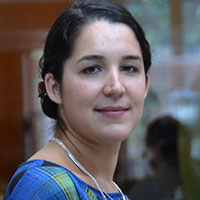Study proves cost-effectiveness of strategies to increase rates of HPV vaccination
December 21, 2020

Dr. Jennifer Spencer
Recent research published in Pediatrics by a team of faculty and alumnae of the UNC Gillings School of Global Public Health shows that existing interventions to increase human papillomavirus (HPV) vaccinations are cost-effective. According to Jennifer Spencer, PhD, recent alumna of the Gillings School’s Department of Health Policy and Management and lead author of the article, policymakers can help alleviate health disparities by acting on these findings.
“We have tools and knowledge to prevent and treat disease, but those who are already disadvantaged in our society often have less access to them,” said Spencer. “A vaccine that can protect against six types of cancer is just an amazing breakthrough, and I think we have an obligation to make sure that this benefit can be shared by everyone.”
The rest of the team comprised Noel T. Brewer, PhD; Justin G. Trogdon, PhD; Morris Weinberger, PhD; Tamera Coyne-Beasley, MD, MPH, alumna of the Department of Epidemiology; and Stephanie B. Wheeler, PhD.
Infection with HPV dramatically increases risk of cervical cancer, but vaccination effectively reduces this risk, which, in turn, decreases risk of cancer. However, rates of vaccination in the United States fall well below the recommended 80% coverage goal.
To enable policymakers to make decisions based on value, the team analyzed the cost-effectiveness of interventions proven to increase rates of vaccination. To do so, they developed a model to dynamically simulate infection and cancer progression, which captures such details as effects of herd immunity.
“There’s so much that goes into understanding the impact of a vaccine like this,” said Spencer, “particularly when you’re modeling something where the benefits happen 30–50 years after the intervention.”
The team investigated three types of intervention: quality-improvement visits, which assess vaccination practices at pediatric clinics and provide feedback; centralized reminder recall, which relies on a central, statewide database to alert parents when their children are due for vaccination; and in-school vaccination programs.
The researchers evaluated cost, from the perspective of a medium-sized U.S. state government, and quality-adjusted life years (QALY) over a 50-year period following each intervention. They found that all three interventions cost less than traditional thresholds for value – $50,000 per QALY gained – classifying all as effective compared to no intervention.
Quality-improvement visits had the lowest total cost but the smallest benefit, whereas school-located vaccination had the highest total cost but the greatest benefit. Together, these interventions could avert an estimated 3,000–14,000 cases of cancer resulting from HPV.
These findings led the researchers to recommend that policymakers implement quality-improvement visits, at a minimum, and consider the other two interventions if budgets allow for the additional expense.
In addition to these important recommendations for policymakers, the team demonstrated the utility of advanced methods of evaluation to inform policy.
“These results shed light on the population-level cost and health outcome tradeoffs associated with implementing different evidence-based interventions to increase HPV vaccination and indicate that the interventions evaluated are expected to be cost-effective,” said study coauthor Stephanie B. Wheeler. “Such evidence could meaningfully prevent HPV cancers and associated cancer deaths. The power of these findings, however, lies in the willingness of decision makers, including policy makers, to invest in implementing such interventions.”
Contact the UNC Gillings School of Global Public Health communications team at sphcomm@unc.edu.
